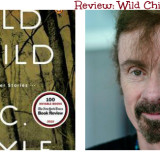Each story in Wild Child by T.C. Boyle is assured, in-your-face, and perfectly executed; he is a master of the genre. The stories are so deep and insightful that I could imagine any one of them being extended into a full-length, absorbing novel. His themes seem peculiarly contemporary and American – very much of their place and time, but not as if that is a limitation. With the exception of two stories, this is California incarnate: immigrants, people of Asian and Latino descent, sushi, coastal and island scenery, the music and movie biz. Boyle alternates expertly between third- and first-person narration, and his tales are rich with foreboding and tragic potential. Many begin with a simple hint of menace: a hidden gun, a small lie that becomes overblown, a few pet rats that horrifyingly, nauseatingly multiply to 1300.
I am convinced Boyle could write an engrossing story on any subject, but especially interesting for me is his preoccupation with cutting-edge science, including conservation: there is an imagined new ‘Scopes monkey’ trial, debating the right of teachers to teach on evolution in schools (“Bulletproof”), the cloning of beloved pets (“Admiral”), organ transplantation (“La Conchita”), the possibility of a person never feeling pain (“Sin Dolor”), gratuitous cosmetic surgery (“Hands On”), and house cats threatening songbird populations (“Question 62” – similar in theme to Jonathan Franzen’s Freedom). There are also foretastes of the subject matter of When the Killing’s Done, such as the plague of rats and a boat trip out towards Anacapa island.
“Wild Child,” the final novella of 60-some pages, is the only historical story, but unlike, say, the final story in Wells Towers’s collection, Everything Ravaged, Everything Burned, it does not feel strained or out of place here. Boyle retells the story of Victor, the ‘Wild Boy of Aveyron,’ and specifically his training with Doctor Itard. Feral children are fascinating test subjects for questions of domestication versus wildness, instincts versus learned behavior, and so on. A few years ago I read an intriguing study of the feral child phenomenon (Savage Girls and Wild Boys, by Michael Newton), and it’s no surprise to me that authors find the idea inspiring. As Boyle asks of Victor’s experience:
What must it have been like to be abandoned, to have your throat cut, to be captured and imprisoned and without defense except to sink your teeth into the slowest and weakest of your tormentors? To throw off your clothes, indifferent to the cold? To cower and hide and hunger?
Wild children occupy a rare gray area between humans and animals and thus provide a kind of metaphor for Boyle’s concerns: what the relationship is – and/or should be – between mankind and nature, and how human interaction can transcend mere beastly reactions.


